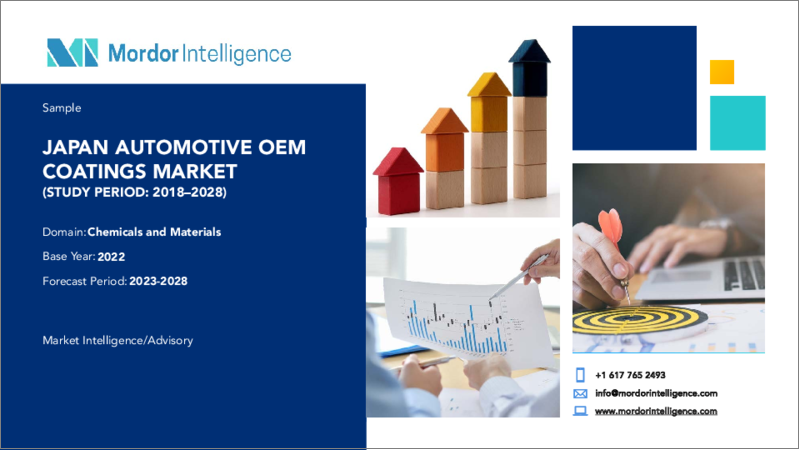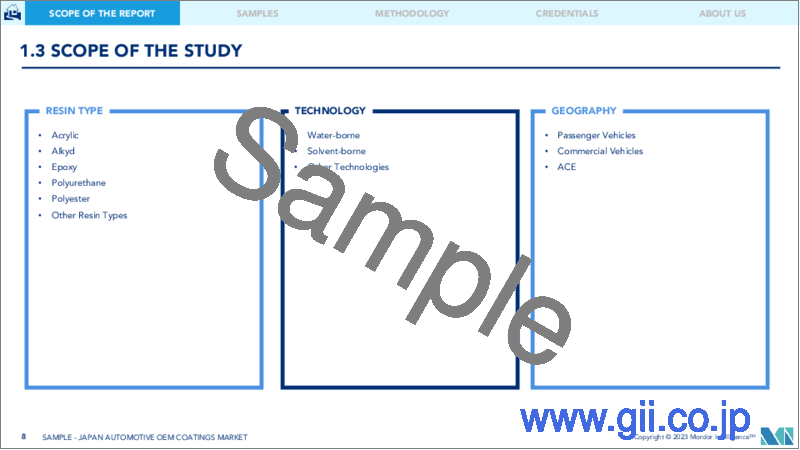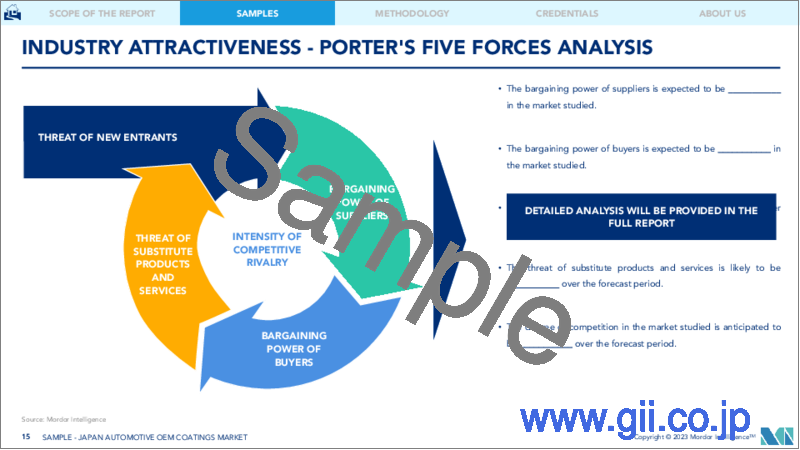|
|
市場調査レポート
商品コード
1200881
日本の自動車用OEMコーティング市場- 成長、動向、予測(2023年-2028年)Japan Automotive Oem Coatings Market - Growth, Trends, and Forecasts (2023 - 2028) |
||||||
|
● お客様のご希望に応じて、既存データの加工や未掲載情報(例:国別セグメント)の追加などの対応が可能です。 詳細はお問い合わせください。 |
|||||||
| 日本の自動車用OEMコーティング市場- 成長、動向、予測(2023年-2028年) |
|
出版日: 2023年01月23日
発行: Mordor Intelligence
ページ情報: 英文 80 Pages
納期: 2~3営業日
|
- 全表示
- 概要
- 目次
日本の自動車用OEMコーティング市場は、本年末までに9億米ドルと評価されました。
同市場は予測期間中にCAGR4.5%を記録すると予測されています。2020年にはCOVID-19が市場にマイナスの影響を与えました。しかし、現在、市場は流行前の水準に達したと推定され、安定的に成長すると予測されています。
主なハイライト
- 市場成長の原動力となるのは、電気自動車やハイブリッド車の需要増です。
- 一方、半導体やその他の部品の不足は、自動車用OEMコーティングの需要にマイナスの影響を与える可能性が高いです。
- バイオベースコーティングの選択肢の増加は、予測期間中、調査された市場に機会を提供する可能性があります。
自動車用OEMコーティングの国内市場動向
電気自動車とハイブリッド車に対する需要の増加
- 日本は、中国と米国に次いで世界第3位の自動車メーカーです。日本の自動車市場は、トヨタ、日産、ホンダ、スズキ、三菱といった国内メーカーが中心となっています。
- 日本では、EVメーカーの集積が進んでいることに加え、環境意識の高まりや二酸化炭素排出への懸念から、EVの需要が高まっています。また、電気自動車(EV)、ハイブリッド車(HEV)、プラグインハイブリッド車(PHEV)は、CO2排出量を削減する有望な技術であると考えられています。
- さらに、日本政府は2035年までに販売するすべての新車を環境にやさしいものにするという目標を発表しています。そのため、日本の自動車メーカーは、EVの販売拡大に積極的に取り組んでいます。例えば、2022年5月、日本の業界大手であるトヨタは、同社初の量産型EVモデルである電気SUV「bZ4X」を日本で発売しました。そして、日産自動車は電気SUVの「Ariya」を発売しました。
- さらに、2021年、日本におけるEV車の販売台数は、他の自動車と比較して伸びています。例えば、日本自動車販売協会連合会(JADA)によると、2021年の新車販売台数は3,675,650台で、電気自動車は40.5%と2020年と比較して約4%の増加となっています。その結果、自動車用OEMコーティングの需要が増加しています。
- また、政府は電気自動車購入のための補助金を提供しています。例えば、2021年のエコカー補助金は、1台あたり7,200米ドルが最高額とされています。
- したがって、前述の事実と要因によって、予測期間中に自動車用OEMコーティングの成長率が高くなると思われます。
水性塗料が市場を席巻
- 市場の大半を占めるのは溶剤型技術ですが、予測期間中は緩やかな成長が続くと予想されます。
- トルエン、キシレン、エチルベンゼン、メチルエチルケトンなど、溶剤型自動車用OEMコーティングに含まれる有害大気汚染物質によるVOC排出を規制する規制が、溶剤型自動車用OEMコーティングの拡大を阻む大きな要因の1つになっています。
- 水性自動車用OEMコーティングは、継続的に変化する環境規制のためにますます人気が高まっています。水系塗料は、溶剤系塗料と同等の性能を実現するために、常に開発が進められています。例えば、水性塗料の性能と乾燥時間を向上させるために、マイルドな共溶媒還元剤や添加剤が開発されています。
- 自動車用水性塗料の採用が拡大しているのは、高い耐薬品性、低い処理温度、無溶剤処方といった物理的・化学的品質が理由です。
- 上記の要因から、水系技術は予測期間中に大きく成長すると予想されます。
その他の特典
- エクセル形式の市場予測(ME)シート
- アナリストによる3ヶ月間のサポート
目次
第1章 イントロダクション
- 調査の前提条件
- 調査範囲
第2章 調査手法
第3章 エグゼクティブサマリー
第4章 市場力学
- 市場概要
- 市場促進要因
- 電気自動車・ハイブリッド車の需要拡大
- その他の促進要因
- 市場抑制要因
- 継続的な半導体不足
- その他の阻害要因
- 産業バリューチェーン分析
- ポーターズ5フォース分析
- 新規参入業者の脅威
- 買い手/消費者の交渉力
- 供給企業の交渉力
- 代替品の脅威
- 競争企業間の敵対関係
第5章 市場セグメンテーション(金額ベース市場規模)
- 樹脂の種類
- エポキシ系
- アクリル系
- アルキド
- ポリウレタン
- ポリエステル
- その他樹脂系
- 技術
- 水性
- 溶剤型
- その他
- エンドユーザー産業
- 乗用車
- 商用車
- エース
第6章 競合情勢
- M&A、合弁事業、協業、契約書
- 市場シェア(%)**/ランキング分析
- 主要なプレーヤーが採用した戦略
- 企業プロファイル
- AkzoNobel N.V.
- Axalta Coating Systems, LLC
- BASF SE
- Beckers Group
- Jotun
- Nippon Paint Holdings Co., Ltd
- PPG Industries, Inc.
- RPM International Inc
- Teknos Group
- The Sherwin-Williams Company
第7章 市場機会と今後の動向
- バイオベースコーティングの選択肢の増加
The Japan Automotive OEM Coatings Market was valued at USD 900 million by the end of this year. The market is projected to register a CAGR of 4.5% during the forecast period. COVID-19 negatively impacted the market in 2020. However, the market has now been estimated to have reached pre-pandemic levels and is forecasted to grow steadily.
Key Highlights
- The driving factors that tend to the market growth include rising demand for electric and hybrid vehicles.
- On the flip side, shortages of semiconductors and other components are likely to negatively affect the demand for Auto OEM coatings consumption in the country.
- The growing options for bio-based coatings are further likely to provide opportunities for the studied market during the forecast period.
Japan Automotive OEM Coatings Market Trends
Increasing Demand for Electric and Hybrid Vehicles
- Japan is the world's third-largest automotive manufacturer, following China and the United States. The Japanese automobile market is dominated by domestic manufacturers such as Toyota, Nissan, Honda, Suzuki, and Mitsubishi.
- In Japan, the rising demand for electric vehicles is being driven by a high concentration of EV manufacturers, as well as increased environmental consciousness and concern about carbon emissions. Also, Electric Vehicles (EVs), Hybrid Electric Vehicles (HEV), and Plug-in Hybrid Electric Vehicles (PHEVs) are considered to be promising technology for reducing CO 2 emissions.
- Additionally, The Government of Japan (GOJ) has announced a goal: by 2035, all new automobiles sold will be environmentally friendly. As a result, Japanese automakers are pushing aggressively to increase EV sales. For Instance, In May 2022, Japanese industry leader Toyota released the bZ4X electric SUV, its first mass-produced EV model, in Japan. And Nissan Motor released the Ariya, an electric SUV.
- Furthermore, In 2021, EV car sales in Japan have grown compared to Other Vehicles. For Instance, According to the Japan Automobile Dealers Association (JADA), 3,675,650 new cars were sold in 2021, and 40.5 % were electric vehicles which is around a 4% increase compared to 2020. Thus, resulting in increasing demand for automotive OEM coatings.
- Also, The Govt is providing subsidies for the purchase of new electric vehicles. For Example, In 2021, the highest amount of eco-friendly car subsidies available per vehicle is 7,200 USD.
- Hence, the aforementioned facts and factors will likely result in a higher growth rate for automotive OEM coating during the forecast period.
Water-borne Coating Dominate the Market
- Although solvent-borne technology accounts for most of the market, it is predicted to grow slowly over the forecast period.
- Regulations governing VOC emissions from hazardous air pollutants contained in solvent-borne automotive OEM coatings such as toluene, xylene, ethylbenzene, and methyl ethyl ketone are one of the major factors limiting the expansion of solvent-borne automotive OEM coatings.
- Water-based automotive OEM coatings are becoming increasingly popular due to the continuously changing environmental regulations. Water-based coatings are constantly developing to provide the same performance as solvent-based coatings. For example, mild co-solvent reducers and additives are being developed to improve water-based coatings' performance and drying times.
- The increasing adoption of waterborne automotive coatings is due to their physical and chemical qualities, such as high chemical resistance, low processing temperature, and solvent-free formulations.
- Owing to above mentioned factor, waterborne technology is expected to grow significantly during the forecast period.
Japan Automotive OEM Coatings Market Competitor Analysis
The Japan Automotive OEM Coatings Market is consolidated, as the majority of the market share is divided among a few companies. Some of the key players in the market include (not in any particular order) Axalta Coating Systems, BASF SE, Nippon Paint Holdings Co., Ltd., PPG Industries Inc., and Kansai Paint CO. Ltd, among others.
Additional Benefits:
- The market estimate (ME) sheet in Excel format
- 3 months of analyst support
TABLE OF CONTENTS
1 INTRODUCTION
- 1.1 Study Assumptions
- 1.2 Scope of the Study
2 RESEARCH METHODOLOGY
3 EXECUTIVE SUMMARY
4 MARKET DYNAMICS
- 4.1 Market Overview
- 4.2 Market Drivers
- 4.2.1 Increasing Demand for Electric and Hybrid Vehicles
- 4.2.2 Other Drivers
- 4.3 Market Restraints
- 4.3.1 Ongoing Shortage of Semiconductors
- 4.3.2 Other Restraints
- 4.4 Industry Value Chain Analysis
- 4.5 Porters 5 Force Analysis
- 4.5.1 Threat of New Entrants
- 4.5.2 Bargaining Power of Buyers/Consumers
- 4.5.3 Bargaining Power of Suppliers
- 4.5.4 Threat of Substitute Products
- 4.5.5 Intensity of Competitive Rivalry
5 MARKET SEGMENTATION (Market Size in Value)
- 5.1 Resin Type
- 5.1.1 Epoxy
- 5.1.2 Acrylic
- 5.1.3 Alkyd
- 5.1.4 Polyurethane
- 5.1.5 Polyester
- 5.1.6 Other Resin Type
- 5.2 Technology
- 5.2.1 Water-borne
- 5.2.2 Solvent-borne
- 5.2.3 Others
- 5.3 End-user Industry
- 5.3.1 Passenger Cars
- 5.3.2 Commercial Vehicles
- 5.3.3 ACE
6 COMPETITIVE LANDSCAPE
- 6.1 Mergers and Acquisitions, Joint Ventures, Collaborations, and Agreements
- 6.2 Market Share (%) **/Ranking Analysis
- 6.3 Strategies Adopted by Leading Players
- 6.4 Company Profiles
- 6.4.1 AkzoNobel N.V.
- 6.4.2 Axalta Coating Systems, LLC
- 6.4.3 BASF SE
- 6.4.4 Beckers Group
- 6.4.5 Jotun
- 6.4.6 Nippon Paint Holdings Co., Ltd
- 6.4.7 PPG Industries, Inc.
- 6.4.8 RPM International Inc
- 6.4.9 Teknos Group
- 6.4.10 The Sherwin-Williams Company
7 MARKET OPPORTUNITIES AND FUTURE TRENDS
- 7.1 The growing options for bio-based coatings.




